Digital health sits at the intersection of medicine, technology, and policy, so the best journals reflect that range. Some focus on clinical validation and data science, while others explore system-level impact or patient engagement.
Here are eight respected journals that consistently publish credible, high-impact work across the digital health spectrum — from applied telemedicine research to policy analysis and data-driven innovation.
Telehealth and Medicine Today
Telehealth and Medicine Today is an open-access, peer-reviewed journal covering telemedicine, virtual care, automation, policy, and implementation in digital health. It is indexed in Scopus, ProQuest, and Google Scholar but does not yet have a formal impact factor.
The journal reports an acceptance rate of about 55 % and publishes quarterly, with submission deadlines in February, May, August, and November. The article processing charge is USD 650 (USD 450 for students).
THMT’s readership includes clinicians, researchers, and policymakers working on telehealth innovation and digital care delivery. It offers a practical outlet for applied research and implementation studies with real-world impact.
Submissions should focus on measurable outcomes, scalability, or policy relevance, and adhere to the journal’s quarterly publication schedule.
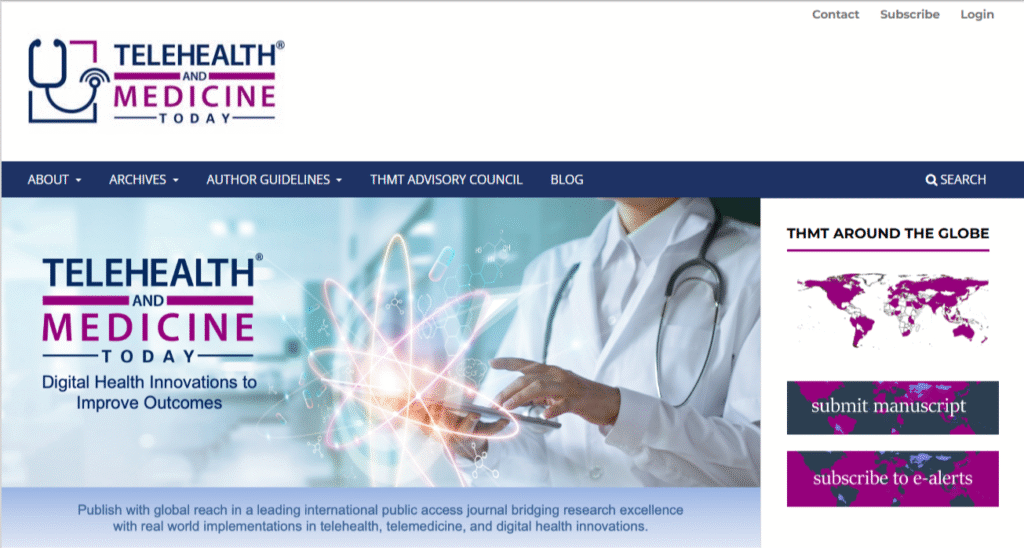
Telemedicine Reports
Telemedicine Reports is a peer-reviewed, open-access companion journal to Telemedicine and e-Health. It publishes original research, clinical trials, and case studies on telehealth, mobile health, and remote care delivery.
The journal has an official impact factor of 1.6, but it is indexed in PubMed Central and Scopus, supporting broad discoverability. It provides a faster review cycle than its parent journal, with an emphasis on practical, early-stage or implementation-focused research.
The audience includes clinicians, researchers, and digital health developers seeking a credible but accessible venue for telehealth evidence. Article processing charges of USD 2,500 apply, consistent with Mary Ann Liebert’s open-access policy.
Submissions should highlight measurable patient outcomes, technology feasibility, or health system integration.

Health Affairs Scholar
Health Affairs Scholar is a peer-reviewed, open-access journal from Health Affairs that focuses on emerging research in health policy, health systems, and digital innovation. It serves as an early-stage platform for applied studies, implementation research, and technology-enabled care delivery.
The journal is newly indexed and has an official impact factor of 2.7. It also follows the rigorous editorial standards of Health Affairs. It aims for a median submission-to-decision time of 24 to 38 days.
Health Affairs Scholar reaches a policy-focused audience that includes researchers, industry leaders, and government decision-makers. Its open-access model supports wide dissemination of evidence relevant to digital health policy and adoption.
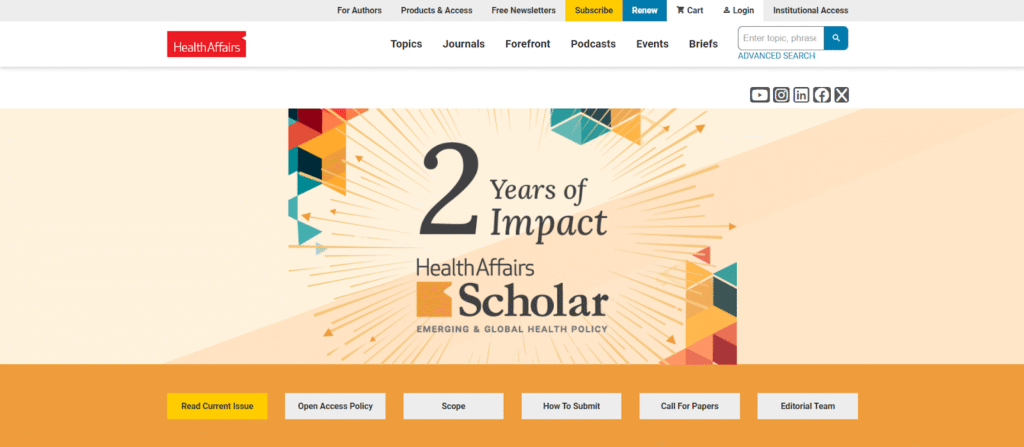
Public Library of Science (PLOS) Digital Health
PLOS Digital Health is an open-access journal from the Public Library of Science (PLOS) publishing research on digital tools, AI, mobile health, wearables, and data-driven healthcare.
It has an official impact factor of 7.7 but is indexed in Scopus and Web of Science. The journal follows PLOS’s open peer-review model and transparent reporting standards. The article processing charge is USD 3,043, with waivers available.
Its readership includes researchers, clinicians, and technologists working at the intersection of health and data science. The journal emphasizes reproducibility, ethical data use, and measurable impact on health outcomes.
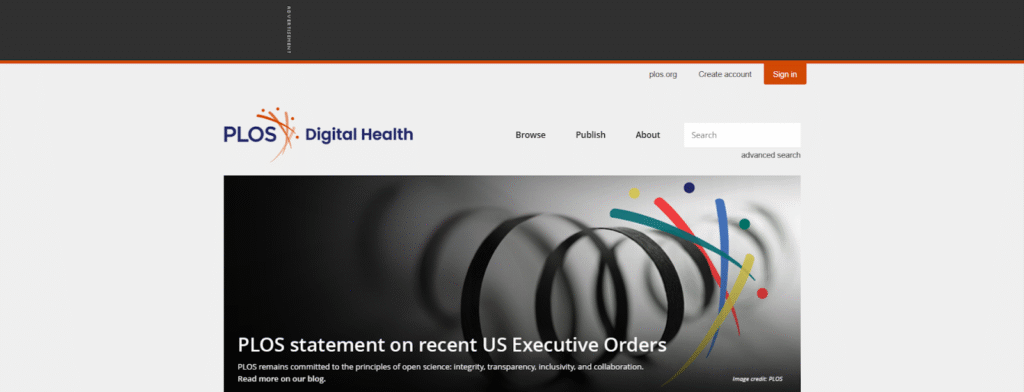
Telemedicine and e-Health
Telemedicine and e-Health is one of the longest-running, peer-reviewed journals focused on telemedicine, digital care delivery, and connected health systems. Published by Mary Ann Liebert, it is considered a flagship title in the field.
It has a 2025 impact factor of 2.0 and is indexed in MEDLINE, Scopus, and Web of Science. The journal’s readership includes clinicians, health system executives, and digital health researchers worldwide. The submission fee is USD 49, and article processing charges of USD 3,600 apply for open-access publication.
Telemedicine and e-Health is highly regarded for applied, implementation-focused research.
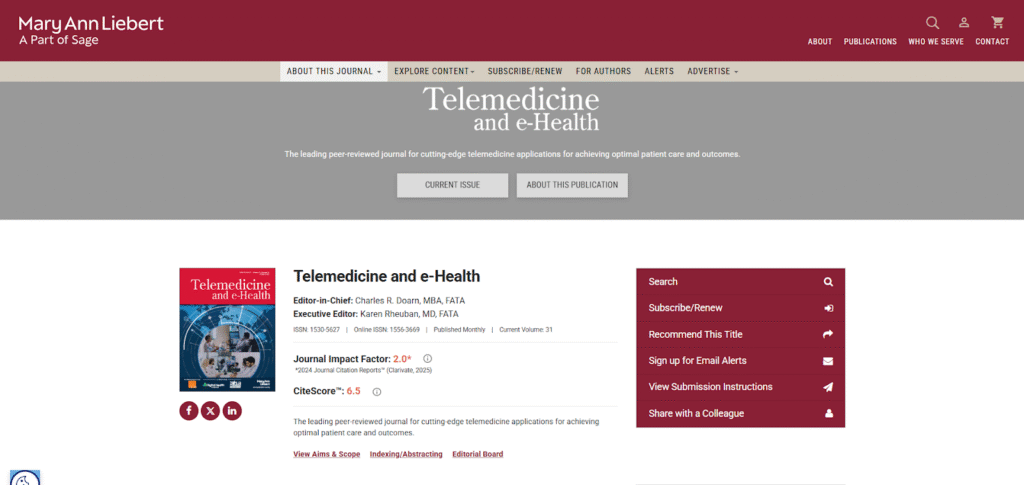
Journal of the American Medical Informatics Association (JAMIA)
Journal of the American Medical Informatics Association (JAMIA) is the flagship peer-reviewed journal of the American Medical Informatics Association. It publishes original research on clinical informatics, data science, digital health systems, and applied AI in medicine.
It had a 2024 impact factor of 4.6 (5.9 over five years) and ranks among the top journals in medical informatics. JAMIA is indexed in MEDLINE, Scopus, and Web of Science.
The journal’s readership includes academic researchers, clinical leaders, and digital health professionals. It is known for methodological rigor and strong relevance to clinical implementation.
Submissions should demonstrate innovation, scientific soundness, and reproducibility. Authors must adhere to AMIA’s reporting and data-sharing guidelines.
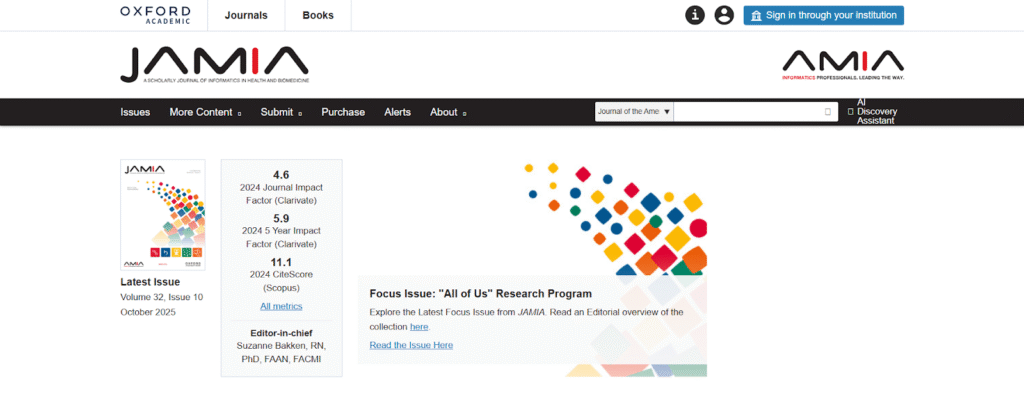
Sage Digital Health
Sage Digital Health is an open-access, peer-reviewed journal covering digital technologies in healthcare, including telemedicine, digital therapeutics, data analytics, and connected devices. It has a 2025 impact factor of 3.3 and is indexed in Scopus and Web of Science.
Average submission-to-publication time is about 15 weeks. The journal attracts researchers, clinicians, and industry experts focused on applied digital health. Article processing charges of USD 3,200 apply, with waivers available. Submissions should emphasize methodological rigor and real-world health impact.

Journal of Medical Internet Research (JMIR)
Journal of Medical Internet Research (JMIR) is one of the most established open-access journals in digital health. It publishes work on eHealth, mHealth, telemedicine, AI, and digital interventions. JMIR has a 2025 impact factor of 6.0 and ranks in the top quartile for medical informatics and healthcare sciences.
The journal targets both academic and industry readers interested in clinical validation of digital tools. Typical review timelines are four weeks, with a fast-track option for time-sensitive work. The article processing charge is USD 3,350 for full-length research articles, with reduced rates for shorter article types and waivers available for authors from low- and middle-income countries.
For digital health companies, JMIR offers strong visibility and credibility, especially for studies linking product use to clinical outcomes. Submissions must follow digital health reporting standards such as CONSORT-EHEALTH.

Building Early Media and Academic Relationships
Publishing in credible journals is only part of the visibility strategy for digital health companies. The impact of clinical evidence depends on how well it is shared, discussed, and connected to broader narratives in healthcare innovation.
1. Engage editors and reviewers early
Establish contact with journal editors (in-person or online) or attend conferences where they speak to help align your research with a journal’s priorities. Understanding what types of studies they are currently seeking can improve both acceptance chances and relevance.
2. Coordinate publication with communications teams
Work with PR and marketing teams to plan around anticipated publication dates. Aligning releases, social content, and webinars with a publication can maximize attention from clinicians, investors, and media outlets that track evidence-driven innovation.
3. Use media to amplify peer-reviewed work
Mainstream and trade publications increasingly cover peer-reviewed digital health studies. Sharing findings with journalists through embargoed releases or editor briefings — or even penning op-eds — can increase reach and reinforce credibility, especially when results are clinically significant.
Building these relationships early helps digital health teams move beyond a single paper toward sustained visibility, positioning their research — and brand — as part of the ongoing evidence conversation in healthcare.
Conclusion
Choosing the right outlet is more than a publishing decision; it shapes how your work is seen, cited, and applied. By pairing strong research with a clear communication strategy, digital health teams can extend the reach of their evidence, influence practice and policy, and help define the future of connected care.
Considering journal publication as part of your healthcare GTM strategy? We work with digital health companies on US market entry and expansion by aligning their product’s value proposition with the needs of health systems. Reach out today to start a conversation.






